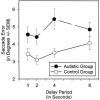Oculomotor evidence for neocortical systems but not cerebellar dysfunction in autism
- PMID: 10102406
- PMCID: PMC2995853
- DOI: 10.1212/wnl.52.5.917
Oculomotor evidence for neocortical systems but not cerebellar dysfunction in autism
Abstract
Objective: To investigate the functional integrity of cerebellar and frontal systems in autism using oculomotor paradigms.
Background: Cerebellar and neocortical systems models of autism have been proposed. Courchesne and colleagues have argued that cognitive deficits such as shifting attention disturbances result from dysfunction of vermal lobules VI and VII. Such a vermal deficit should be associated with dysmetric saccadic eye movements because of the major role these areas play in guiding the motor precision of saccades. In contrast, neocortical models of autism predict intact saccade metrics, but impairments on tasks requiring the higher cognitive control of saccades.
Methods: A total of 26 rigorously diagnosed nonmentally retarded autistic subjects and 26 matched healthy control subjects were assessed with a visually guided saccade task and two volitional saccade tasks, the oculomotor delayed-response task and the antisaccade task.
Results: Metrics and dynamics of the visually guided saccades were normal in autistic subjects, documenting the absence of disturbances in cerebellar vermal lobules VI and VII and in automatic shifts of visual attention. Deficits were demonstrated on both volitional saccade tasks, indicating dysfunction in the circuitry of prefrontal cortex and its connections with the parietal cortex, and associated cognitive impairments in spatial working memory and in the ability to voluntarily suppress context-inappropriate responses.
Conclusions: These findings demonstrate intrinsic neocortical, not cerebellar, dysfunction in autism, and parallel deficits in higher order cognitive mechanisms and not in elementary attentional and sensorimotor systems in autism.
Figures


Comment in
-
Autism in search of a home in the brain.Neurology. 1999 Mar 23;52(5):902-4. doi: 10.1212/wnl.52.5.902. Neurology. 1999. PMID: 10102402 No abstract available.
-
Autism's home in the brain.Neurology. 2000 Jan 11;54(1):269-70. doi: 10.1212/wnl.54.1.269. Neurology. 2000. PMID: 10636173 No abstract available.
Similar articles
-
Positron emission tomography study of voluntary saccadic eye movements and spatial working memory.J Neurophysiol. 1996 Jan;75(1):454-68. doi: 10.1152/jn.1996.75.1.454. J Neurophysiol. 1996. PMID: 8822570
-
Oculomotor abnormalities parallel cerebellar histopathology in autism.J Neurol Neurosurg Psychiatry. 2004 Sep;75(9):1359-61. doi: 10.1136/jnnp.2003.022491. J Neurol Neurosurg Psychiatry. 2004. PMID: 15314136 Free PMC article.
-
Neocortical system abnormalities in autism: an fMRI study of spatial working memory.Neurology. 2002 Sep 24;59(6):834-40. doi: 10.1212/wnl.59.6.834. Neurology. 2002. PMID: 12297562
-
Cerebellar control of saccadic eye movements: its neural mechanisms and pathways.Jpn J Physiol. 1991;41(3):351-68. doi: 10.2170/jjphysiol.41.351. Jpn J Physiol. 1991. PMID: 1960885 Review.
-
Role of the Vermal Cerebellum in Visually Guided Eye Movements and Visual Motion Perception.Annu Rev Vis Sci. 2019 Sep 15;5:247-268. doi: 10.1146/annurev-vision-091718-015000. Epub 2019 Jul 12. Annu Rev Vis Sci. 2019. PMID: 31299168 Review.
Cited by
-
The role of attention control in complex real-world tasks.Psychon Bull Rev. 2022 Aug;29(4):1143-1197. doi: 10.3758/s13423-021-02052-2. Epub 2022 Feb 15. Psychon Bull Rev. 2022. PMID: 35167106 Free PMC article. Review.
-
Limited attentional bias for faces in toddlers with autism spectrum disorders.Arch Gen Psychiatry. 2010 Feb;67(2):178-85. doi: 10.1001/archgenpsychiatry.2009.194. Arch Gen Psychiatry. 2010. PMID: 20124117 Free PMC article.
-
Greater disruption to control of voluntary saccades in autistic disorder than Asperger's disorder: evidence for greater cerebellar involvement in autism?Cerebellum. 2011 Mar;10(1):70-80. doi: 10.1007/s12311-010-0229-y. Cerebellum. 2011. PMID: 21072692
-
Electrophysiological Endophenotypes for Schizophrenia.Harv Rev Psychiatry. 2016 Mar-Apr;24(2):129-47. doi: 10.1097/HRP.0000000000000110. Harv Rev Psychiatry. 2016. PMID: 26954597 Free PMC article. Review.
-
Sensory-movement underpinnings of lifelong neurodivergence: getting a grip on autism.Front Integr Neurosci. 2025 Apr 14;19:1489322. doi: 10.3389/fnint.2025.1489322. eCollection 2025. Front Integr Neurosci. 2025. PMID: 40297515 Free PMC article.
References
-
- Rapin I. Autism. N Engl J Med. 1997;337:97–104. - PubMed
-
- Minshew NJ. Autism. In: Berg BO, editor. Principles of child neurology. McGraw-Hill; New York: 1996. pp. 1713–1729.
-
- Minshew NJ. Brain mechanisms in autism: functional & structural abnormalities. J Autism Dev Disord. 1996;26:389–406. - PubMed
-
- Minshew NJ, Sweeney JA, Bauman ML. Neurologic aspects of autism. In: Cohen DJ, Volkmar FR, editors. Handbook of autism and pervasive developmental disorders. 2nd ed. John Wiley & Sons; New York: 1997. pp. 344–369.
-
- Piven J, Arndt S, Bailey J, Havercamp S, Andreasen NC, Palmer P. An MRI study of brain size in autism. Am J Psychiatry. 1995;152:1145–1149. - PubMed
Publication types
MeSH terms
Grants and funding
LinkOut - more resources
Full Text Sources
